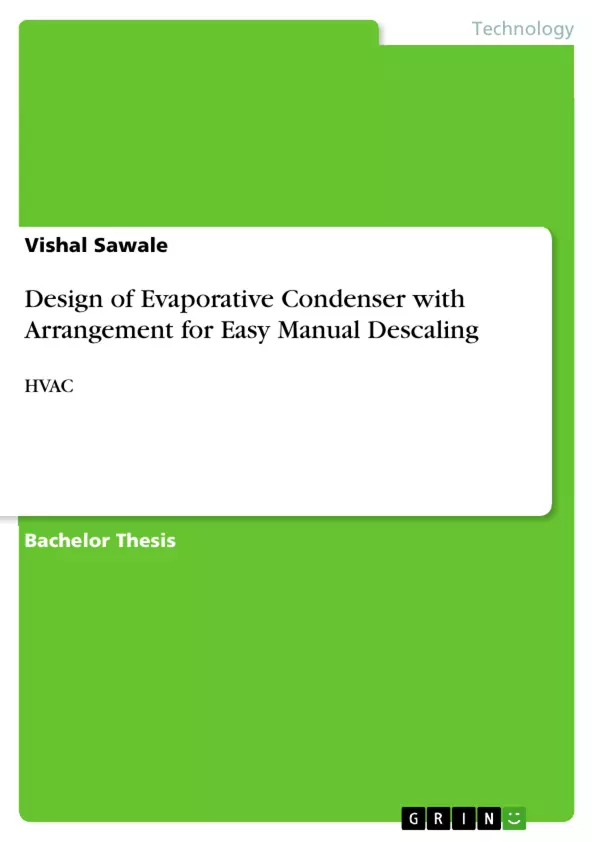Evaporative cooling takes advantage of the potential of the outside air in dry climates to absorb moisture, which results in a temperature reduction of the air stream. But one of the major drawbacks is the continuous scale built up on condenser tubes which makes a barrier between tubes and water sprayed on them, which in turn drastically reduces the heat transfer. This results in a loss of plant efficiency and increases annual refrigeration costs as the compressor work increases for compensating the pressure drop due to scaling.
In HVAC around 27% of worldwide energy is consumed only for different HVAC applications. This project mainly focuses on this problem statement, if the scale is 0.06mm then condenser performance decreases by 16%. A mainly evaporative condenser is used in different HVAC applications.
In order to overcome this problem, regular maintenance of the condenser should be done by descaling the coils. Various descaling methods are being used in industries descaling like mechanical descaling, chemical descaling, etc. But manual descaling is preferred over other methods due to its simplicity, less cost, and reliability. Yet there are some problems in manual descaling like the number of rows of condensing tubes is very large in numbers and also the pitch between them is less so it becomes very difficult to reach the deep portion of the evaporative condenser in order to clean them thoroughly and effectively scale removal.
Inhaltsverzeichnis (Table of Contents)
- List of Tables
- List of Figures
- List of Photographs/ Plates
- Acknowledgement
- Chapter 1: Introduction
- 1.1: Refrigeration System
- 1.1.1: Working Principle of Refrigeration System
- 1.1.2: Refrigeration Cycle
- 1.2: Types of Condensers
- 1.2.1: Air Cooled Condensers
- 1.2.2: Water Cooled Condensers
- 1.2.2.1: Tube in Tube Condensers
- 1.2.2.2: Shell and Coil Condensers
- 1.2.2.3: Shell and Tube Condensers
- 1.2.3: Evaporative Condensers
- 1.3: Descaling
- 1.3.1: Reasons for Scaling
- 1.3.2: Methods of Descaling
- 1.4: Objectives of the Project
- 1.5: Scope of the Project
- Chapter 2: Literature Review
- Chapter 3: System Description
- Chapter 4: Design Considerations
- Chapter 5: Design Calculations
- Chapter 6: Selection of Materials
- Chapter 7: Distribution System
- Chapter 8: Air Circulation System
- Chapter 9: Descaling System
- Chapter 10: Scaling
- Chapter 11: Water Chemistry
- Chapter 12: Cost Analysis
- Chapter 13: Fabrication and Assembly
- Chapter 14: Results and Discussions
Zielsetzung und Themenschwerpunkte (Objectives and Key Themes)
This dissertation focuses on the design of an evaporative condenser with a system for easy manual descaling. The primary goal is to develop a practical and efficient solution for addressing the challenges posed by scaling in evaporative condensers. The work explores the working principles of refrigeration systems, different types of condensers, and the causes and implications of scaling. It examines various design considerations, including heat transfer calculations, material selection, distribution systems, and air circulation. Furthermore, the project investigates different descaling methods and analyzes the cost-effectiveness of the proposed design.- Design and development of an evaporative condenser
- Addressing scaling issues in condensers
- Heat transfer calculations and optimization
- Material selection and fabrication
- Cost analysis and economic feasibility
Zusammenfassung der Kapitel (Chapter Summaries)
- Chapter 1: This chapter introduces the concept of refrigeration systems, their working principles, and different types of condensers. It also discusses the problem of scaling in evaporative condensers and the objectives of the project.
- Chapter 2: This chapter reviews existing literature on evaporative condensers, descaling techniques, and relevant design considerations.
- Chapter 3: This chapter details the proposed design for the evaporative condenser, including its components and operational principles.
- Chapter 4: This chapter discusses various design considerations, such as heat transfer calculations, material selection, and optimization of the design.
- Chapter 5: This chapter presents detailed design calculations for different components of the evaporative condenser.
- Chapter 6: This chapter explores the selection of appropriate materials for the condenser, considering factors like corrosion resistance and cost-effectiveness.
- Chapter 7: This chapter focuses on the design and implementation of the distribution system for water in the evaporative condenser.
- Chapter 8: This chapter describes the air circulation system, which plays a crucial role in the cooling process of the condenser.
- Chapter 9: This chapter details the descaling system incorporated in the design, highlighting its mechanism and ease of operation.
- Chapter 10: This chapter examines the phenomenon of scaling in condensers and discusses its detrimental effects on performance.
- Chapter 11: This chapter analyzes the chemical composition of water used in the condenser and its implications for scaling formation.
- Chapter 12: This chapter presents a cost analysis of the proposed design, comparing it to traditional evaporative condensers.
- Chapter 13: This chapter describes the fabrication and assembly process of the evaporative condenser, including details of the construction and integration of different components.
Schlüsselwörter (Keywords)
The core concepts and themes explored in this dissertation include evaporative condensers, refrigeration systems, scaling, descaling, heat transfer, design considerations, cost analysis, and material selection. The project emphasizes the practical implications of these concepts for the development of an efficient and scalable solution for evaporative condenser design.- Quote paper
- Vishal Sawale (Author), 2018, Design of Evaporative Condenser with Arrangement for Easy Manual Descaling, Munich, GRIN Verlag, https://www.grin.com/document/1289700



